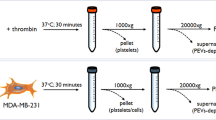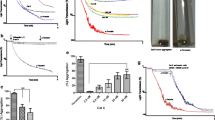Murine 15091A mammary adenocarcinoma cells and membrane vesicles spontaneously shed from these tumor cells in culture can induce aggregation of washed human platelets. A spectrum of proteinase inhibitors was tested for their ability to inhibit 15091A induced platelet aggregation. Of the inhibitors tested the most effective were those selective for cysteine proteinases. The effect of the spectrum of proteinase inhibitors on 15091A induced platelet aggregation was compared to the effect on cathepsin B-like cysteine proteinase activity in homogenates of 15091A tumor cells and their spontaneously shed vesicles. The results suggest that there is a correlation between activity of a cathepsin B-like proteinase in 15091A cells and vesicles and the ability of these cells and vesicles to induce aggregation of washed human platelets.
Similar content being viewed by others
References
Alexander, B., Pechet, L., and Kliman, A., 1962, Proteolysis, fibrinolysis and coagulation. Circulation, 26, 596–611.
Barrett, A. J., 1973, Human cathepsin B1. Purification and some properties of the enzyme. Biochemical Journal, 131, 809–822.
Barrett, A. J., 1980, Fluorimetric assays for cathepsin B and cathepsin H with methylcoumarylamide substrates. Biochemical Journal, 187, 909–912.
Bastida, E., Ordinas, A., Giardina, S. L., and Jamieson, G. A., 1982, Differentiation of platelet-aggregation effects of human tumor cell lines based on inhibition studies with apyrase, hirudin and phospholipase. Cancer Research, 42, 4348–4352.
Bastida, E., Ordinas, A., and Jamieson, G. A., 1981, Idiosyncratic platelet responses to human tumor cells. Nature, 291, 661–662.
Curatolo, L., Colucci, M., Cambini, A. L., Poggi, A., Morasca, L., Donati, M. B., and Semeraro, N., 1979, Evidence that cells from experimental tumours can activate coagulation factor X. British Journal of Cancer, 48, 228–233.
Dvorak, H. F., Quay, S. C., Orenstein, N. S., Dvorak, A. M., Hahn, P., Bitzer, A. M., and Carvalho, A. C., 1981, Tumor shedding and coagulation. Science, 212, 923–924.
Gasic, G. J., Boettiger, D., Catalfamo, J. L., Gasic, T. B., and Stewart, G. J., 1978, Aggregation of platelets and cell membrane vesiculation by rat cells transformed in vitro by Rous sarcoma virus. Cancer Research, 38, 2950–2955.
Gasic, G. J., Catalfamo, J. L., Gasic, T. B., and Avdalovic, N., 1981, In vitro mechanism of platelet aggregation by purified plasma membrane vesicles shed by mouse 15091A tumor cells. Malignancy and the Hemostatic System, edited by M. B. Donati, J. F. Davidson and S. Garattini (New York: Raven Press), pp. 27–35.
Gasic, G. J., and Gasic, T. B., 1982, Plasma membrane vesicles as mediators of interactions between tumor cells and components of the hemostatic and immune systems. Interaction of Platelets and Tumor Cells, edited by G. A. Jamieson (New York: Alan Liss), pp. 429–443.
Gasic, G. J., Gasic, T. B., and Jimenez, S. A., 1977, Platelet aggregating material in mouse tumor cells. Removal and regeneration. Laboratory Investigation, 36, 413–419.
Gasic, G. J., Gasic, T. B., and Stewart, C. C., 1968, Antimetastatic effects associated with platelet reduction. Proceedings of the National Academy of Sciences, U.S.A., 61, 46–52.
Gordon, S. G., 1981, A proteolytic procoagulant associated with malignant transformation. The Journal of Histochemistry and Cytochemistry, 29, 457–463.
Gordon, S. G., and Cross, B. A., 1981, A factor X activating cysteine protease from malignant tissue. Journal of Clinical Investigation, 67, 1665–1671.
Hara, Y., Steiner, M., and Baldini, M. G., 1980, Characterization of the platelet-aggregating activity of tumor cells. Cancer Research, 40, 1217–1222.
Honn, K. V., Busse, W. D., and Sloane, B. F., 1982, Prostacyclin and thromboxanes. Implications of their role in tumor cell metastasis. Biochemical Pharmacology, 32, 1–11.
Honn, K. V., Cicone, B., and Skoff, A., 1981, Prostacyclin: a potent antimetastatic agent. Science, 212, 1270–1272.
Honn, K. V., Cavanaugh, P., Evens, C., Taylor, J. D., and Sloane, B. F., 1982, Tumor cell-platelet aggregation: induced by cathepsin B-like proteinase and inhibited by prostacyclin. Science, 217, 540–542.
Jamieson, G. A., Bastida, E., and Ordinas, A., 1982, Mechanisms of platelet aggregation by human tumor lines. Interaction of Platelets and Tumor Cells, edited by G. A. Jamieson (New York: Alan Liss), pp. 405–413.
Karpatkin, S., and Pearlstein, E., 1981, Role of platelets in tumor cell metastases. Annals of Internal Medicine, 95, 636–641.
Karpatkin, S., Smerling, A., and Pearlstein, E., 1980, Plasma requirement for the aggregation of rabbit platelets by an aggregating material derived from SV40-transformed 3T3 fibroblasts. Journal of Laboratory and Clinical Medicine, 96, 994–1001.
Kirschke, H., and Shaw, E., 1981, Rapid inactivation of cathepsin L by Z-Phe-Phe-CHN2 and Z-Phe-Ala-CHN2. Biochemical Biophysical Research Communications, 101, 454–458.
Menter, D., Neagos, G., Dunn, J. R., Palazzo, R., Tchen, T. T., Taylor, J. D., and Honk, K. V., 1982, Tumor cell induced platelet aggregation: inhibition by prostacyclin, thromboxane AZ and phosphodiesterase inhibitors. Prostaglandins and Cancer, edited by T. J. Powles, R. J. Bockman, K. V. Honn and P. W. Ramwell (New York: Alan Liss), pp. 809–813.
Mustard, J. F., Perry, D. W., Ardlie, N. G., and Packham, M. A., 1972, Preparation of suspension of washed platelets from humans. British Journal of Haematology, 22, 193–204.
Pearlstein, E., Ambrogio, C., Gasic, G., and Karpatkin, S., 1981, Inhibition of the platelet-aggregating activity of two human adenocarcinomas of the colon and an anaplastic routine tumor with a specific thrombin inhibitor, dansylarginine N-(3-Ethyl1,5-pentanediyl)amide. Cancer Research, 41, 4535–4539.
Pearlstein, E., Cooper, L., and Karpatkin, S., 1979, Extraction and characterization of a platelet-aggregating material from SV40-transformed mouse 3T3 fibroblasts. Journal of Laboratory and Clinical Medicine, 93, 332–344.
Pearlstein, E., Salk, P. L., Yogeeswaran, G., and Karpatkin, S., 1980, Correlation between spontaneous metastatic potential, platelet aggregating activity of cell surface extracts, and cell surface sialylation in 10 metastatic-variant derivatives of a rat renal sarcoma line. Proceedings of the National Academy of Sciences, U.S.A. 77, 4336–4339.
Read, S. M., and Northcote, D. H., 1981, Minimization of variation in the response to different proteins of the coomassie blue G dye-binding assay for protein. Analytical Biochemistry, 116, 53–64.
Schwartz, W. N., and Barrett, A. J., 1980, Human cathepsin H. Biochemical Journal, 191, 487–497.
Sloane, B. F., Dunn, J. R., and Honk, K. V., 1981, Lysosomal cathepsin B: correlation with metastatic potential. Science, 212, 1151–1153.
Sloane, B. F., Honn, K. V., Sadler, J. G., Turner, W. A., Kimpson, J. J., and Taylor, J. D., 1982, Cathepsin B activity in B16 melanoma cells: a possible marker for metastatic potential. Cancer Research, 42, 980–986.
Snellman, O., 1971, A study on the reactivity of the thiol group of cathepsin B. Tissue Proteinases, edited by A. J. Barrett and J. T. Dingle (Amsterdam: North-Holland), pp. 29–43.
Takio, K., Towatari, T., Katunuma, N., and Titani, K., 1980, Primary structure study of rat liver cathepsin B—a striking resemblance to papain. Biochemical and Biophysical Research Communications, 97, 340–346.
Umezawa, H., 1972, Enzyme Inhibitors of Microbial Origin, (Tokyo: University of Tokyo Press), pp. 15–52.
Zacharski, L. R., Henderson, W. G., Rickles, F. R., Forman, W. B., Cornell, C. J., Jr., Forcier, R. J., Harrower, H. W., and Johnson, R. O., 1979, Rationale and experimental design for the VA cooperative study of anticoagulation (Warfarin) in the treatment of cancer. Cancer, 44, 732–741.
Author information
Authors and Affiliations
Rights and permissions
About this article
Cite this article
Cavanaugh, P.G., Sloane, B.F., Bajkowski, A.S. et al. Involvement of a cathepsin B-like cysteine proteinase in platelet aggregation induced by tumor cells and their shed membrane vesicles. Clin Exp Metast 1, 297–307 (1983). https://doi.org/10.1007/BF00121192
Received:
Accepted:
Issue Date:
DOI: https://doi.org/10.1007/BF00121192




